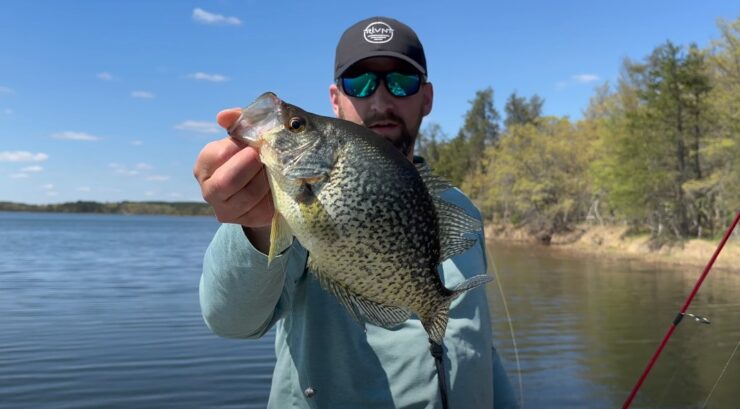As an experienced angler, I’ve shared countless sunrises and sunsets with our gilled friends. I’ve felt the exhilaration of bass taking the bait and the challenge of reeling it in. But every fishing tale starts with the same humble hero – the hook. Today, let’s delve deep into the world of these useful fishing tools, specifically the best sizes for bass. This guide aims to serve as a comprehensive resource for those beginning their bass fishing journey or those looking to refine their technique.
Table of Contents
ToggleA Brief Overview
The size of a fishing hook is one of the essential factors to consider when fishing for bass. The size can significantly influence your success on the water.
Size Chart
It might seem counterintuitive, but sizes are described by numbers. The rule is the larger the number, the smaller the hook. For instance, a size 1 is bigger than a size 8. To further complicate things, once you reach size 1, the scale switches to fractions (1/0, 2/0, and so on) – the higher the fraction, the larger it is.
This might seem confusing, but there’s a logic to it. It’s essential to understand this sizing system to choose the right hook for the bass you’re targeting.
| Size | Best For… |
| Size 1 to 1/0 | Small Bass |
| Size 2/0 to 4/0 | Medium Bass |
| Size 5/0 to 7/0 | Large Bass |
Considerations for Size
The size you choose should match the size of your bait and the bass you’re targeting. Larger hooks are perfect for big baits and bass, while smaller ones work well for smaller baits and fish.
Understanding the different aspects that determine the size will help you make a more informed decision, ensuring your bass fishing experience is both enjoyable and successful.
Types of Bass Hooks
A wide variety of hook types exist, each tailored to a different bass fishing scenario. Having the right type can be a game-changer.
J-Hooks
These are the most traditional type. Named for their shape, they are versatile and perfect for a variety of bait types.
They are suitable for both live and artificial baits. But be cautious with your hook set – a too-aggressive set can cause bass to be foul-hooked.
Circle Type
Circle hooks have a unique design, with the point turned perpendicular to the shank. This design helps to prevent gut-hooking the fish, making it a more sustainable choice for catch-and-release fishing.
Remember, with these, don’t jerk to set the hook. Instead, allow the bass to swim away, which will set the hook in the corner of its mouth.
The Right Choice for the Right Bait

Choosing the right hook is not just about the size but also the style that works best with your chosen bait.
For Live Bait
For live bait, circle and J-hooks are popular choices. Sizes 1 to 1/0 are usually great for small live baits like worms or minnows.
Remember, when fishing with live bait, the key is to keep the bait alive and moving naturally. Thus, the placement is crucial.
For Artificial Bait
With artificial bait like plastic worms, tube baits, or grubs, a wide gap hook (Sizes 2/0 to 4/0) is commonly used to allow for more success.
Artificial bait requires more technique in presenting the lure and setting the hook, so keep practicing to find what works best.
Material and Durability

Durability is an important factor when selecting hooks for bass fishing. You want the one that will withstand the fight of a feisty bass.
Material
Most hooks are made from steel, but the quality can vary. Higher-end ones may be crafted from high-carbon steel for extra strength and rust resistance.
There are also different coatings available, like Teflon or chromium, to enhance longevity and sharpness.
Sharpness
A sharp hook is key to ensuring successful hook-ups. A dull one will not penetrate the bass’s mouth, resulting in missed catches.
Regardless of the material, routinely check and sharpen your hooks. Some anglers prefer to replace them regularly to ensure they’re always fishing with the sharpest tools.
Color

Hook color is often an overlooked aspect of bass fishing. While some anglers stick to the traditional bronze or silver ones, others swear by colored hooks.
Traditional vs Colored Ones
Traditional colors like bronze, silver, or black nickel blend well with most environments. They provide a subtle presentation that doesn’t spook wary bass.
Colored hooks, on the other hand, can act as additional attractants, simulating the colors of prey fish or adding a contrasting hue that can trigger strikes from curious bass.
Selecting Colors
When selecting colored hooks, consider the color of your bait and the water clarity. In clear water, match thecolor to your bait to create a seamless profile. In murky water, contrast can be key to getting noticed.
Remember, while color can make a difference, it’s far from the most critical aspect of your selection.
Anatomy

To master the art of selecting the right bass hook, it’s essential to understand the different parts of them and their functions.
A hook consists of several parts, each serving a unique purpose. The point and barb are what penetrate the fish’s mouth. The shank connects the point to the eye, which is the loop at the end of the hook where the fishing line is tied.
The bend of the hook influences how deep the point penetrates and how securely the fish is held. The gap (distance between the shank and the point) determines the size of the mouth of the fish it can catch.
Variations in Anatomy
Different hook styles have different anatomical variations. For instance, a wide gap one has a larger space between the shank and the point, making it suitable for larger baits and fish.
Understanding how each part functions will help you make better-informed decisions when making a selection for bass fishing.
Etiquettes

While fishing is a sport of personal enjoyment, it’s also essential to respect nature and other anglers.
Catch and Release
If you’re not planning on eating your catch, it’s best to practice catch and release. Use hooks that cause the least damage to the fish, like circle ones.
It’s also essential to handle the bass correctly when removing the hook and releasing it back into the water. Wet your hands first to avoid removing the fish’s protective slime coat, and never hold a bass vertically by the lip, as it can harm its jaw.
Respect for Other Anglers
When on the water, respect the space of other anglers. Don’t crowd someone’s spot, and avoid crossing their line.
Share your knowledge and experiences with others, and you’ll find the fishing community to be a welcoming and supportive one.
Safety

Hooks are sharp tools, and they need to be handled with care to avoid accidents.
Handling
Always be aware of where your hooks are, both when casting and when storing your gear. A loose hook can easily get stuck in your skin, clothes, or equipment.
When handling a fish, be cautious. A struggling fish can cause a hook to become embedded in your hand. It’s often useful to carry a pair of pliers to help with the removal.
Storing
When not in use, keep your hooks stored in a tackle box. Not only does this prevent accidents, but it also helps keep them sharp and rust-free.
As you learn about hook size for bass and how it can maximize your catch, it’s essential to understand the differences between baitcast, spincast, and spinning reels – the basics of fishing reels.
Final Words
To wrap things up, remember that fishing for bass, like any other sport, requires practice and patience. Understanding hooks and choosing the right one for your specific scenario is a significant step toward becoming a successful bass angler.
Related Posts:
- Heavy Duty Fishing: 11 Best Rods And Reels For Big Fish 2024
- 9 Best Backpacking Fishing Rods 2024 - Lightweight…
- 10 Best Fishing Hats in 2024 - Keep Yourself Cool…
- 10 Best Saltwater Fishing Boats - Ultimate Angling Adventure
- 12 Best Motorized Kayak 2024 - Start Your Aquatic Adventure!
- 14 Best Fishing Line for Baitcaster 2024 - For…












